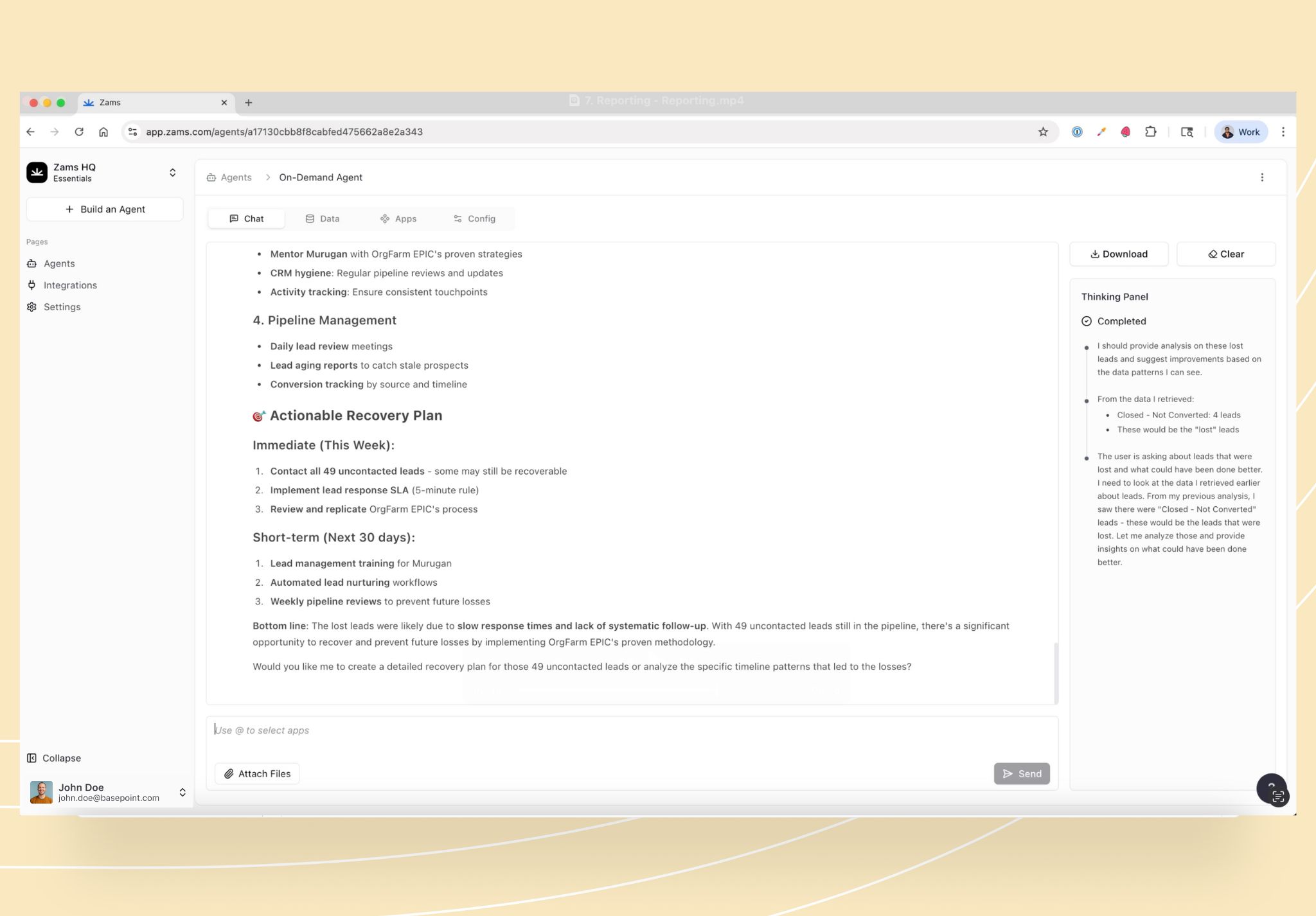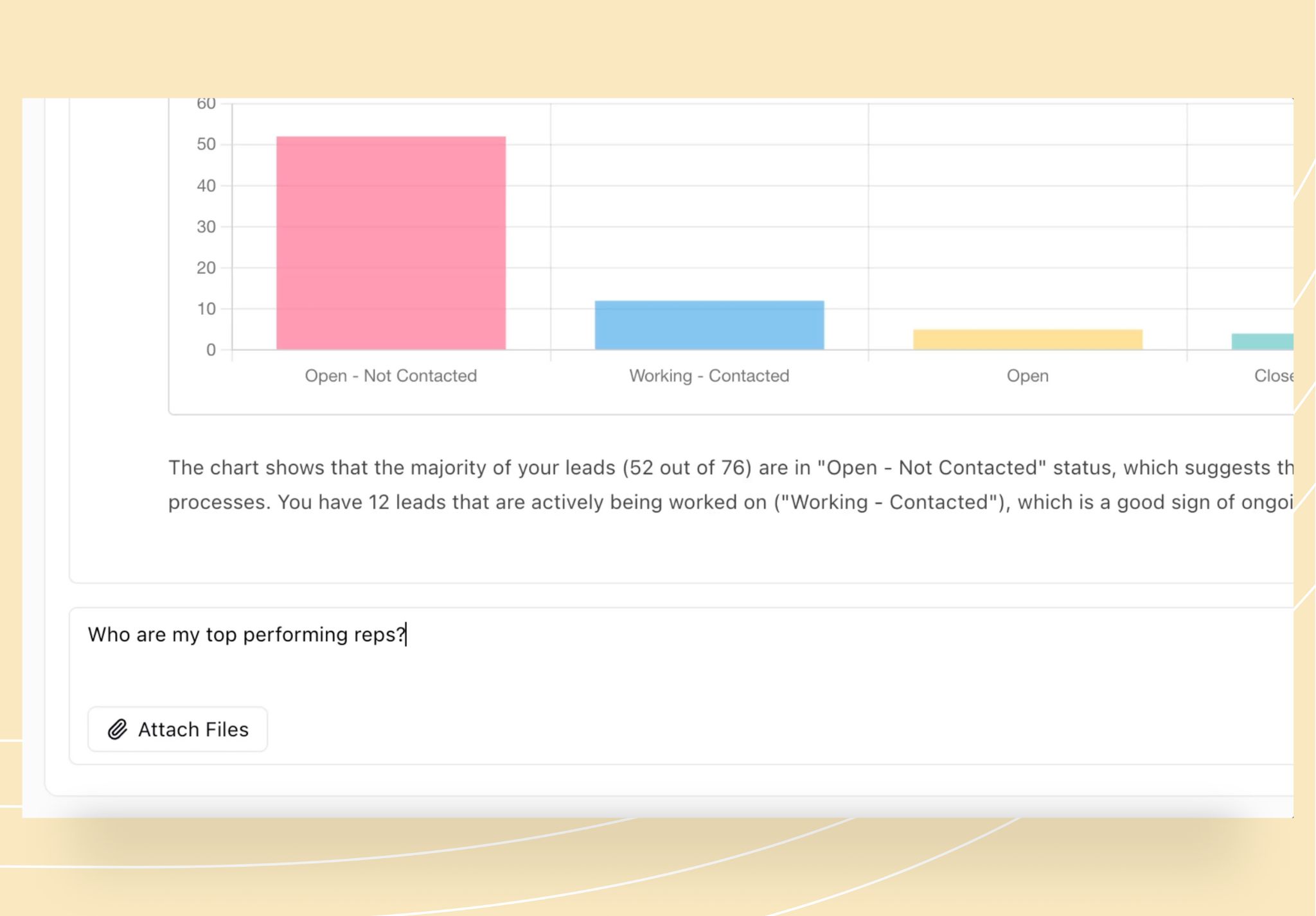Why Manual Data Reporting Is Slowing Growth
The hidden cost of spreadsheet-driven reporting
Relying on spreadsheets for data reporting introduces errors, delays, and wasted time. Sales teams often spend more hours fixing formulas than analysing insights, slowing down the path to revenue growth. Automating reporting processes can save time and allow teams to focus on analysis rather than fixing errors.
Why B2B sales teams can’t scale without automated reporting software
Reports automation allows sales teams to handle growing volumes of customer and pipeline data without drowning in manual work. As organizations grow, reports automation ensures that evolving reporting needs are met efficiently, adapting to increased complexity and user requirements. Automating report generation ensures accuracy, speed, and scalability across the sales organisation.
Missed opportunities when decisions lag behind data
When reporting is delayed, opportunities slip through the cracks. Automated data reporting helps keep reports accurate and up to date, so leaders can trust the insights they act on. Automated data reporting ensures leaders have real-time insights to act faster, close deals sooner, and stay ahead of competitors.
Stop wasting hours on spreadsheets.
With Zams, automate reporting, get live insights, and make revenue decisions in real time, all from one AI command center.
The Core of Automated Data Reporting
What automated reports actually solve for revenue teams
Automated reports eliminate the burden of manual reporting by establishing a robust reporting system to manage and streamline the process, pulling data directly from CRMs, marketing platforms, and other tools by connecting to the right data source for accurate and timely reporting. This gives revenue teams a single source of truth to drive smarter decisions.
Key report automation benefits every sales leader should know
The main report automation benefits include improved data accuracy, greater reporting accuracy, reduced lag time, and more consistent performance tracking. For sales leaders, this means predictable forecasting and faster identification of revenue bottlenecks. Automation also streamlines report creation, making it easier to generate dynamic and insightful reports that adapt to changing data and business conditions.
How reports automation tools free up hours of manual work
Automated reporting tools cut out repetitive admin tasks by generating dashboards, alerts, and performance updates automatically, saving time on routine processes. This saves sales reps and managers dozens of hours each month, freeing them to focus on closing deals. Automation is especially valuable for teams that need to generate the same reports on a recurring basis, as it streamlines the process and ensures consistency.

Business Intelligence: The Foundation of Automated Reporting
Business intelligence (BI) is the backbone of automated reporting, empowering organizations to move beyond basic data collection and into the realm of advanced data analysis and visualization. By leveraging BI platforms, companies can transform their reporting process, enabling faster, more informed decision making at every level. Automated reporting, when built on a strong BI foundation, ensures that teams have access to accurate, up-to-date information that drives business growth.
How BI platforms supercharge automated reporting
BI platforms take automated reporting to the next level by offering powerful features such as seamless data integration, advanced analytics, and interactive dashboards. These reporting tools connect multiple data sources ranging from CRMs to marketing platforms into a unified system, eliminating data silos and manual report generation. With advanced analytics capabilities, BI-driven automated reporting tools can analyze vast amounts of data, uncovering trends and delivering insights that would be impossible to spot manually. Interactive dashboards make it easy for teams to visualize data, track performance, and respond quickly to changing business conditions.
Data Integration for a unified revenue view
One of the greatest strengths of BI platforms is their ability to connect and consolidate multiple data sources, providing a single, unified view of revenue and customer data. Automated reporting tools can pull information from Google Analytics, Google Sheets, and other business systems, ensuring that key performance indicators are tracked accurately across the organization. This integration allows teams to create accurate reports that reflect the full picture, from marketing campaigns to sales performance. By centralizing customer data and metrics, organizations can eliminate inconsistencies and make data-driven decisions with confidence.
BI-driven dashboards for actionable sales insights
BI-driven dashboards are at the heart of effective automated reporting, offering interactive and visual representations of sales data and key metrics. These dashboards enable sales teams to quickly identify opportunities, spot challenges, and monitor progress toward revenue goals. With the ability to create automated reports tailored to specific business needs, organizations can ensure that every stakeholder has access to the insights they need to drive data driven decisions. BI-powered dashboards turn complex data into clear, actionable stories that inform sales strategies and accelerate growth.
Turning Data Automation Into a Competitive Edge
Automated reporting systems that eliminate human error
Manual reporting is prone to mistakes that skew sales forecasts and weaken strategy. Automated reporting systems help maintain data quality by minimizing manual intervention and standardizing processes. Automated reporting systems remove human error by standardising data entry and calculations, ensuring reliable insights every time.
Marketing automation reports that tie campaigns to pipeline impact
Marketing automation reports (a form of marketing reporting designed to provide real-time insights into campaign performance) connect lead generation campaigns directly to sales pipeline performance. By automating campaign tracking, sales teams see exactly which marketing efforts are driving qualified opportunities and revenue growth.
Real-time insights that accelerate revenue decisions
With automated data reporting, decision-makers gain access to real-time dashboards and alerts, powered by real time data integration from multiple sources. This immediacy allows leaders to pivot strategy, prioritise deals, and adjust resources before opportunities are lost.

Data Analytics and Automated Reporting
Data analytics is a critical driver of automated reporting, enabling organizations to turn raw data into revenue-generating insights. By harnessing advanced analytics and machine learning, automated reporting tools can process complex data sets, uncover hidden patterns, and deliver actionable recommendations that fuel business growth.
Transforming raw data into revenue-driving insights
Automated reporting tools excel at analyzing large volumes of raw data, transforming it into meaningful insights that guide business strategy. By applying advanced analytics and machine learning, organizations can create automated reports that highlight key trends, forecast outcomes, and identify new opportunities. This approach not only ensures data accuracy but also reduces the risk of human error that often comes with manual reporting. With automated reporting, teams can create reports that are always up to date, relevant, and tailored to their unique business needs enabling faster, more informed decision making and driving revenue growth.
By combining the power of business intelligence platforms and data analytics, organizations can build automated reporting systems that deliver real-time, actionable insights. The right automated reporting tools make it easy to create interactive dashboards, visual reports, and compelling data stories that turn complex data into clear, strategic guidance. Investing in automated reporting not only saves time and reduces costs but also ensures data accuracy and consistency, giving organizations a competitive edge in today’s fast-paced business environment. With automated reporting, teams can focus on what matters most making data driven decisions that drive business success.
Building a Modern Automated Reporting Stack
Choosing the right automated reporting tools for sales and marketing
Not all automated reporting tools are built the same. Choosing the right automated reporting tool for your business needs is crucial to ensure you get the most value and efficiency from your data processes.
The most effective platforms (these automated reporting tool options should be compared based on features and integration) provide pre-built templates, customisable dashboards, and seamless integration with sales and marketing systems.
Evaluating different reporting tool, reporting software, and report automation tools can help teams find the best fit for their specific reporting requirements.
Integrating CRM, BI, and data automation platforms
A strong automated reporting stack unites CRM systems, BI dashboards, and data automation tools into a single flow, ensuring compatibility with existing systems for seamless workflow. This integration ensures consistency, reduces silos, and allows teams to measure the entire revenue engine end-to-end.
Creating workflows that keep dashboards and stakeholders aligned
Workflows are the glue of modern automated reporting. Automating updates to dashboards and pushing reports directly to stakeholders ensures everyone from reps to executives works from the same accurate data. Automating the distribution of recurring reports ensures consistency and keeps all stakeholders informed.
From Data to Decisions: Proving the ROI
How automated reports shorten sales cycles and improve forecasting
Automated reports provide real-time visibility into deal stages, enabling sales teams to identify bottlenecks and act faster. By automating forecasting and leveraging real-time financial data, leaders gain more accurate projections and can make revenue decisions that shorten the sales cycle.
Linking report automation benefits to rep productivity
Report automation benefits sales reps by removing hours of manual reporting and admin. With automated data reporting, teams spend more time engaging prospects and closing deals, directly boosting productivity and win rates.
Automating the generation of the same report for different periods or teams further reduces manual effort and increases efficiency.
Case for predictable growth with automated reporting systems
Automated reporting systems deliver consistent, trustworthy insights that scale with your business, especially when powered by a business intelligence platform that supports scalability and reliability. This creates the foundation for predictable growth, where revenue is tied to repeatable processes instead of guesswork.

Avoiding Common Mistakes in Automated Data Reporting
Over-automating without context or strategy
Automating reports without clear objectives can create noise instead of clarity. Every automated report should align with revenue goals and deliver insights that directly support decision-making.
Implementing complex automation without the necessary technical expertise can lead to confusion and inefficiency.
Poor integration planning between data automation tools
Disconnected tools lead to inconsistent or incomplete reporting, increasing the risk of poor data governance when systems are not properly integrated. A successful automated data reporting strategy requires seamless integration between CRM, BI, and data automation platforms.
Failing to validate automated reports for accuracy
Even the best automated reporting tools need ongoing validation. Regular checks ensure data accuracy, prevent misleading insights, and maintain trust across sales and marketing teams.
Final Thoughts
Automated data reporting is no longer optional for B2B sales teams it’s the shortcut to faster, smarter revenue decisions. By replacing spreadsheets with automated reporting systems, your team gains real-time insights, eliminates human error, and creates a foundation for predictable growth.
Equip Your Data Reporting with Zams
Zams automates reporting across your entire sales stack, no more wasted hours on manual updates. Make revenue decisions at the speed of automation.
See how the AI command center powers data-driven growth.
FAQ
What is automated data reporting?
Automated data reporting uses software and reporting tools to collect, process, and present sales and marketing data without manual input. Automated data reporting also streamlines data preparation, creating reports, and analyzing data for better insights. It saves time, reduces errors, and ensures teams always work from accurate insights.
How does reports automation benefit B2B sales teams?
Reports automation eliminates spreadsheet overload, and by allowing teams to automate reporting, it further reduces manual effort and speeds up processes. This approach also speeds up decision-making and ties performance data directly to revenue outcomes. It helps sales teams focus on selling rather than manual admin.
What tools are used for automated reporting?
Automated reporting tools often include CRMs, BI platforms, and data automation systems. Examples include business intelligence BI tools, automated reporting software, and platforms like Looker Studio (formerly Google Data Studio). When integrated, they deliver dashboards and reports in real time across the organisation.
Can automated reporting systems improve forecasting?
Yes. Automated reports provide accurate, timely data on pipeline health and rep performance, helping leaders forecast with confidence and shorten sales cycles.
Data scientists can leverage automated reporting systems to build more sophisticated forecasting models.
What mistakes should be avoided with automated data reporting?
Common pitfalls include over-automation without strategy, poor integration between data platforms, and failing to validate report accuracy. When you automate reports, it's crucial to ensure data security and data encryption to protect sensitive information, and to follow visual reporting and data visualization best practices for clear, effective communication. A structured approach ensures maximum ROI.



